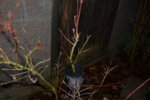b3bowen
Mame
This thread may already exist but I was unable to find it. I have Many cultivars of Japanese maple that I am considering taking air layers from. I was hoping for reference to start a list of Japanese maples that people have been able to successfully grow on their own roots (air layer or cutting). It would also be helpful to know specific cultivars that people have failed to be able to root. I will start the list with my own experience plus those grown and sold at evergreen gardenworks.
Able to root:
Bloodgood
Ryusen
Orange dream
Virdis
Evergreen Gardenworks
'Ao Kanzashi'
'Beni Schichihenge'
'Burgundy Lace'
'Butterfly'
'Coonaria Pygmy'
'Ibo Nishiki'
'Inabe Shidare'
'Katsura'
'Kiyohime'
'Koshimino'
'Mure Hibari'
'Novum'
'Nuresagi'
'Osaka Suki'
palmatum 'Pixie'
'Sazanami'
'Seiryu'
'Sherwood Flame'
'Shindeshojo'
'Whitney Red''
'Yuri Hime'
A. shirasawanum 'Aureum'
A. shirasawanum 'Shir Autumn Moon'
I hear about a lot of difficulty with:
A.P. higasayama
Able to root:
Bloodgood
Ryusen
Orange dream
Virdis
Evergreen Gardenworks
'Ao Kanzashi'
'Beni Schichihenge'
'Burgundy Lace'
'Butterfly'
'Coonaria Pygmy'
'Ibo Nishiki'
'Inabe Shidare'
'Katsura'
'Kiyohime'
'Koshimino'
'Mure Hibari'
'Novum'
'Nuresagi'
'Osaka Suki'
palmatum 'Pixie'
'Sazanami'
'Seiryu'
'Sherwood Flame'
'Shindeshojo'
'Whitney Red''
'Yuri Hime'
A. shirasawanum 'Aureum'
A. shirasawanum 'Shir Autumn Moon'
I hear about a lot of difficulty with:
A.P. higasayama








